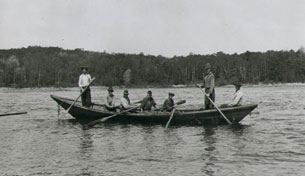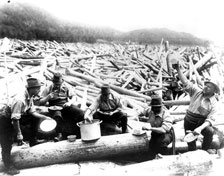- HomePeopleFoundersPeople of NoteStoriesTransportRoadRailRiverLoggingThe CutThe DriveSocial ImpactCreditsThe Log Drives Before the Dams

Raftsmen in their pointer on the log drive in the early 1920s. After the spring break-up in late April or early May, river driving began. A large crew of men, usually seventy or more, equipped with peaveys and pike poles, broke the log dumps and started the log drive down the river. This was arduous and often dangerous work. The drivers‘ clothing was wet from daylight to dark, and they were plagued by mosquitoes and blackflies. It took experienced river hogs to withstand the hardships. They transported themselves by six-oared boats called “pointers” and lived under canvas. The driving season usually lasted from early May until some time in July.
The Log Booms

Raftsmen in their pointer on the log drive in the early 1920s. The true drive experts were the men who learned to use the available water with skill and care, the men who could work quickly and accurately to find the “key” log in a jam, who knew the proper use of dynamite and of driving water. The use of drive water must be governed by the proper disbursement of extra water from reserve dams. An expert could size up the water flow at the tail of a sweep, and accurately gauge how many dam drops it would take to raise the water at the tail of the sweep by a given amount for the required number of hours. It was a developed art, and was properly recognized as such. The sticking of a river drive can cost thousands of dollars. In the old days the management of the drive was emphasised. It was a delight to watch experienced river drivers go to work, determine the key log or logs in a jam, and almost immediately open up the whole jam. They were all very quick of foot and had good reflexes.






